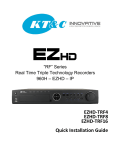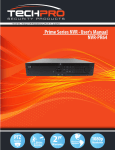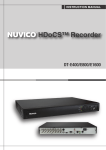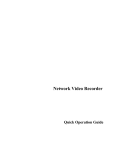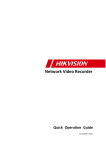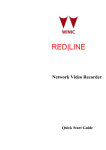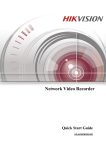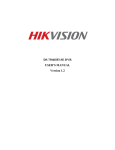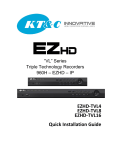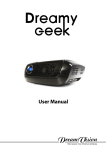Download Please Click Here For AR505-8 QOG
Transcript
Digital Video Recorder Quick Operation Guide Quick Operation Guide of Digital Video Recorder TABLE OF CONTENTS DVR Pre-Installation ....................................................................................................................................... 5 DVR Installation .............................................................................................................................................. 5 Hard Disk Installation ..................................................................................................................................... 5 Front Panels...................................................................................................................................................... 7 Rear Panels ....................................................................................................................................................... 9 Peripheral Connections ................................................................................................................................. 10 Wiring of Alarm Input ........................................................................................................................... 10 Wiring of Alarm Output ........................................................................................................................ 10 Alarm Connection .................................................................................................................................... 10 RS-485 and Controller Connection .......................................................................................................... 11 Termination Switch Operation ................................................................................................................. 12 Specifications .................................................................................................................................................. 13 Table 1 Specification ................................................................................................................................ 13 HDD Storage Calculation Chart ................................................................................................................... 14 Accessing by Web Browser ............................................................................................................................ 15 Logging In................................................................................................................................................ 15 Live View ................................................................................................................................................. 15 Recording ................................................................................................................................................. 16 Playback ................................................................................................................................................... 17 Log ........................................................................................................................................................... 18 Menu Operation ............................................................................................................................................. 19 Menu Structure......................................................................................................................................... 19 Startup and Shutdown .............................................................................................................................. 19 Live View ................................................................................................................................................. 20 Adding IP Cameras .................................................................................................................................. 20 Record ...................................................................................................................................................... 22 Instant Recording ............................................................................................................................. 22 All-day Recording ............................................................................................................................ 22 Playback ................................................................................................................................................... 23 Backup ..................................................................................................................................................... 24 VCA Alarm .............................................................................................................................................. 25 Access by Cloud P2P ............................................................................................................................... 25 1 Quick Operation Guide of Digital Video Recorder Regulatory information FCC information FCC compliance: This equipment has been tested and found to comply with the limits for a digital device, pursuant to part 15 of the FCC Rules. These limits are designed to provide reasonable protection against harmful interference when the equipment is operated in a commercial environment. This equipment generates, uses, and can radiate radio frequency energy and, if not installed and used in accordance with the instruction manual, may cause harmful interference to radio communications. Operation of this equipment in a residential area is likely to cause harmful interference in which case the user will be required to correct the interference at his own expense. FCC conditions This device complies with part 15 of the FCC Rules. Operation is subject to the following two conditions: 1. This device may not cause harmful interference. 2. This device must accept any interference received, including interference that may cause undesired operation. EU Conformity Statement This product and - if applicable - the supplied accessories too are marked with "CE" and comply therefore with the applicable harmonized European standards listed under the Low Voltage Directive 2006/95/EC, the EMC Directive 2004/108/EC, the RoHS Directive 2011/65/EU. 2012/19/EU (WEEE directive): Products marked with this symbol cannot be disposed of as unsorted municipal waste in the European Union. For proper recycling, return this product to your local supplier upon the purchase of equivalent new equipment, or dispose of it at designated collection points. For more information see: www.recyclethis.info. 2006/66/EC (battery directive): This product contains a battery that cannot be disposed of as unsorted municipal waste in the European Union. See the product documentation for specific battery information. The battery is marked with this symbol, which may include lettering to indicate cadmium (Cd), lead (Pb), or mercury (Hg). For proper recycling, return the battery to your supplier or to a designated collection point. For more information see: www.recyclethis.info. 2 Quick Operation Guide of Digital Video Recorder Trademarks and Registered Trademarks Windows and Windows mark are trademarks or registered trademarks of Microsoft Corporation in the United States and/or other countries. HDMI, HDMI mark and High-Definition Multimedia Interface are trademarks or registered trademarks of HDMI Licensing LLC. The products contained in this manual are authorized by HDMI Licensing LLC with the use right of the HDMI technology. VGA is the trademark of IBM. UPnPTM is a certification mark of the UPnPTM Implementers Corporation. Other names of companies and product contained in this manual may be trademarks or registered trademarks of their respective owners. 3 Quick Operation Guide of Digital Video Recorder Thank you for purchasing our product. If there is any question or request, please do not hesitate to contact dealer. This manual is applicable to 1.5U chassis 1080p Turbo HD DVR. This product has default user name and password credentials for first time access. You must change these default credentials to protect against unauthorized access to the product. 4 Quick Operation Guide of Digital Video Recorder DVR Pre-Installation The HD-TVI series DVR is highly advanced surveillance equipment that should be installed carefully. Please take into consideration the following precautionary steps before installation of the DVR. 1. Keep all liquids away from the DVR. 2. Install the DVR in a well-ventilated and dust-free area. 3. Ensure environmental conditions meet factory specifications. 4. Install a manufacturer recommended HDD. DVR Installation During the installation of the DVR: 1. 2. 3. 4. 5. 6. 7. 8. Use brackets for rack mounting. Ensure there is ample room for audio and video cables. When installing cables, ensure that the bend radius of the cables are no less than five times than its diameter. Connect both the alarm and RS-485 cable. Allow at least 2cm (≈0.75-inch) of space between racks mounted devices. Ensure the DVR is grounded. Environmental temperature should be within the range of -10 ºC ~ 55 ºC, 14ºF ~ 131ºF. Environmental humidity should be within the range of 10% ~ 90%. Hard Disk Installation Before you start: Before installing a hard disk drive (HDD), please make sure the power is disconnected from the DVR. A factory recommended HDD should be used for this installation. Up to 4 SATA hard disks can be installed on your DVR. Tools Required: Screwdriver. As the installation steps of HDD are similar among different models, here we take one model as an example. Steps: 1. Remove the cover from the DVR by unfastening the screws on the back and side. 2. Connect one end of the data cable to the motherboard of DVR and the other end to the HDD. 5 Quick Operation Guide of Digital Video Recorder 3. Connect the power cable to the HDD. 4. Place the HDD on the bottom of the device and then fasten the screws on the bottom to fix the HDD. 5. Re-install the cover of the DVR and fasten screws. 6 Quick Operation Guide of Digital Video Recorder Front Panels Front Panel of 4ch/8ch/16ch Description of Front Panel No. 1 2 3 4 5 Name POWER ON/OFF USB Interface IR Receiver POWER READY STATUS ALARM HDD Tx/Rx DVD-ROM DIRECTION 6 ENTER SHIFT 1/MENU 7 2ABC/F1 Function Description Power on/off switch. Connect to USB mouse or USB flash memory. Receiver for IR remote control. devices. Power indicator lights in green when DVR is powered up. Ready indicator is normally green, indicating that the DVR is functioning properly. Indicator turns green when DVR is controlled by an IR remote control with the address from 1~254; Indicator turns red when the SHIFT button is used; Indicator does not light when the DVR is controlled by a keyboard or by the IR remote control with the address of 255; Indicator turns green when the DVR is controlled by IR remote control (with the address from 1~254) and keyboard at the same time , and the SHIFT button is not used; Indicator turns orange : (a) when the DVR is controlled by IR remote control (with the address from 1~254) and keyboard at the same time and the SHIFT button is used as well; (b) when the DVR is controlled by IR remote control (with the address from 1~254) and the SHIFT button is used. Alarm indicator turns red when a sensor alarm is detected. HDD indicator blinks in red when data is being read from or written to HDD. TX/RX indictor blinks in green when network connection is functioning properly. Slot for DVD-ROM. The DIRECTION buttons are used to navigate between different fields and items in menus. In Playback mode, the Up and Down button is used to speed up and slow down recorded video. In All-day Playback mode, the Left/Right button can be used to select the recorded video of next/previous day; in Playback by Normal Video Search, the Left/Right button can be used to select the next/previous recorded file. In Live View mode, the directional buttons can be used to cycle through channels. In PTZ control mode, it can control the movement of the PTZ camera. Confirm selection in any of the menu modes. It can also be used to tick checkbox fields. In Playback mode, it can be used to play or pause the video. In Single-frame Playback mode, pressing the ENTER button will advance the video by a single frame. In Auto-switch mode, it can be used to stop /start auto switch. Switch of compound keys between the numeric/letter input and functional control. Enter numeral “1”; Access the main menu interface. Enter numeral “2”; Enter letters “ABC”; The F1 button can be used to select all items on the list; In PTZ Control mode, the F1 button can be used to zoom out (zoom-) the PTZ camera; In live view or playback mode, the F1 button can be used to switch between main and spot video output. 7 Quick Operation Guide of Digital Video Recorder 3DEF/F2 4GHI/ESC 5JKL/EDIT 6MNO/PLAY 7PQRS/REC 8TUV/PTZ 9WXYZ/PREV 0/A 8 JOG SHUTTLE Control Enter numeral “3”; Enter letters “DEF”; In PTZ Control mode, the F1 button can be used to zoom in (zoom+) the PTZ camera; The F2 button can be used to cycle through tab pages. Enter numeral “4”; Enter letters “GHI”; Exit and back to the previous menu. Enter numeral “5”; Enter letters “JKL”; Delete characters before cursor; Select the checkbox and ON/OFF switch; Start/stop record clipping in playback. Enter numeral “6”; Enter letters “MNO”; In Playback mode, it is used for direct access to playback interface. Enter numeral “7”; Enter letters “PQRS”; Manual record, for direct access to manual record interface; manually enable/disable record. Enter numeral “8”; Enter letters “TUV”; Access PTZ control interface. Enter numeral “9”; Enter letters “WXYZ”; Multi-camera display in live view; In Playback mode or MenuPlaybackTag playback interface, this button can be used to delete the selected tag. Enter numeral “0”; Switch between input methods (upper and lowercase alphabet, symbols and numeric input). In Playback mode, this button can be used to add the default tag. Move the active selection in a menu. The inner ring will move the selection up and down; the outer ring will move it left and right. In Playback mode, the inner ring is used to jump 30s forward/backward in video files. The outer ring can be used to speed up/slow down the video. In Live View mode, it can be used to cycle through different channels. In PTZ control mode, in can control the movement of the PTZ camera. 8 Quick Operation Guide of Digital Video Recorder Rear Panels The rear panel vaires according to different models. Description of Rear Panel No. Item Description 1 VIDEO IN BNC interface for TVI and analog video input. 2 VIDEO OUT BNC connector for video output. 3 AUDIO IN RCA connector 4 USB Port Universal Serial Bus (USB) port for additional devices. 5 HDMI HDMI video output connector. 6 VGA DB15 connector for VGA output. Display local video output and menu. 7 AUDIO OUT RCA connector 8 Network Interface Connector for network 9 RS-485 Interface Connector for RS-485 devices. T+ and T- pins connect to R+ and Rpins of PTZ receiver respectively. D+, D- pin connects to Ta, Tb pin of controller. For cascading devices, the first DVR’s D+, D- pin should be connected with the D+, D- pin of the next DVR. Connector for alarm input. Connector for alarm output. 10 Power Supply AC 100 ~ 240V power supply. 11 Power Switch Switch for turning on/off the device. 12 GND Ground 13 LINE IN BNC connector for audio input. 14 eSATA Connects external SATA HDD, CD/DVD-RW. 15 RS-232 Interface Connector for RS-232 devices. 9 Quick Operation Guide of Digital Video Recorder Peripheral Connections Wiring of Alarm Input The alarm input is an open/closed relay. To connect the alarm input to the device, use the following diagram. If the alarm input is not an open/close relay, please connect an external relay between the alarm input and the device. Wiring of Alarm Output To connect to an alarm output (AC or DC load), use the following diagram: DC Load Connection Diagram AC Load Connection Diagram For DC load, the jumpers can be used within the limit of 12V/1A safely. To connect an AC load, jumpers should be left open (you must remove the jumper on the motherboard in the DVR). Use an external relay for safety (as shown in the figure above). There are 4 jumpers (JP1, JP2, JP3, and JP4) on the motherboard, each corresponding with one alarm output. By default, jumpers are connected. To connect an AC load, jumpers should be removed. Example: If you connect an AC load to the alarm output 3 of the DVR, then you must remove the JP 3. Alarm Connection To connect alarm devices to the DVR: 1. Disconnect pluggable block from the ALARM IN /ALARM OUT terminal block. 2. Press and hold the orange part of the pluggable block; insert signal cables into slots and release the orange part. Ensure signal cables are in tight. 10 Quick Operation Guide of Digital Video Recorder 3. Connect pluggable block back into terminal block. RS-485 and Controller Connection Series 1 To connect PTZ to the DVR: 1. Disconnect pluggable block from the RS-485 terminal block. 2. Press and hold the orange part of the pluggable block; insert signal cables into slots and release the orange part. Ensure signal cables are in tight. 3. Connect A+ on PTZ to D+ on terminal block and B- on controller to D- on terminal block. Fasten stop screws. 4. Connect pluggable block back into terminal block. Series 2 To connect PTZ to the DVR: 1. Disconnect pluggable block from the RS-485 terminal block. 2. Press and hold the orange part of the pluggable block; insert signal cables into slots and release the orange part. Ensure signal cables are in tight. 3. Connect A+ on PTZ to T+ on terminal block and B- on controller to T- on terminal block. Fasten stop screws. 4. Connect pluggable block back into terminal block. To connect a controller to the DVR: 1. Disconnect pluggable block from the KB terminal block. 2. Press and hold the orange part of the pluggable block; insert signal cables into slots and release the orange part. Ensure signal cables are in tight. 11 Quick Operation Guide of Digital Video Recorder 3. Connect Ta on controller to D+ on terminal block and Tb on controller to D- on terminal block. Fasten stop screws. 4. Connect pluggable block back into terminal block. Make sure both the controller and DVR are grounded. Termination Switch Operation This function is applicable to certain models only. The termination switch is placed on the mainboard instead of the rear panel. Open the upper cover and turn on/off the SW switch if needed. Purpose: To connect the DVR with several speed domes, the bus topology can be adopted, which means the speed domes are connected with each other via the R+ and R- of RS-485 serial interface. But due to the impedance of 485 wire, the longer the wire is, the greater the impedance gets. To avoid the signal reduction caused by the great impedance of long distance transmission, please connect two 120Ω resistors in the circuit: one resistor between the DVR and the nearest speed dome, and the other one after the furthest speed dome. Steps: 1. Turn on the SW switches on the DVR and the furthest speed dome. 2. Keep other SW switches off. The connection diagram and status of each SW switch are shown in the following figure. 12 Quick Operation Guide of Digital Video Recorder Specifications Table 1 Specification Model 4ch Video compression H.264 16ch 8-ch 16-ch Analog and HD-TVI 4-ch video input BNC interface (1.0Vp-p, 75 Ω) Supported camera types 720P/25, 720P/30, 720P/50, 720P/60, 1080P/25, 1080P/30, CVBS Video/Audio input 8ch 2-ch (Up to 6ch) 2-ch (Up to 10ch) 2-ch (Up to 18ch) IP video input Up to 2MP resolution Audio compression G.711u Audio input 4-ch, RCA (2.0 Vp-p, 1 KΩ) Two-way audio in 1-ch, RCA (2.0 Vp-p, 1 KΩ) HDMI / VGA output 1920 ×1080/60 Hz ,1280 ×1024/60 Hz, 1280 ×720/60 Hz, 1024 ×768/60 Hz CVBS output 1-ch, BNC (1.0 Vp-p, 75 Ω), resolution: PAL: 704 × 576, NTSC: 704 × 480 Main stream: 1080P / 720P / VGA / 4CIF / CIF Encoding resolution Sub-stream: WD1 (non-real-time)/ 4CIF(non-real-time) / CIF / QCIF / QVGA Main stream: 1/16 fps ~ Real time frame rate Frame rate Sub-stream: 1/16 fps ~ Real time frame rate Video/Audio Video bitrate 32 Kbps-10 Mbps Audio output 2-ch, RCA (Linear, 1KΩ, for VGA output and CVBS output respectively) Audio bitrate 64 Kbps Dual-stream Support Stream type Video, Video & Audio Synchronous playback 4-ch Playback resolution 1080P / 720P / VGA / WD1 / 4CIF / CIF / QVGA / QCIF Remote connection 128 output 8-ch 16-ch Network management TCP/IP, PPPoE, DHCP, DNS, DDNS, NTP, SADP, SMTP, SNMP, NFS, iSCSI, Network protocols UPnP™, HTTPS Type 4 SATA interfaces for 4 HDDs; 1 eSATA interface Capacity Up to 4 TB capacity for each disk Network interface 1; 10M / 100M / 1000M self-adaptive Ethernet interface External Serial interface RS-232, RS-485, Keyboard interface USB port 3 ×USB2.0 Alarm in / out 16 / 4 Power supply 100 ~ 240VAC, 47 ~ 63HZ Hard disk Consumption ≤ 30W ≤ 40W (without hard disks) General Working temperature -10 ºC ~+55 ºC (14 ºF ~ 131 ºF) Working humidity 10% ~ 90% Chassis 19-inch rack-mounted 1.5U chassis Dimensions (W × D × H) 445 ×390 ×70 mm (17.5 ×15.3 ×2.7 inch) Weight ≤5Kg (11.0lb) (without hard disks) 13 ≤ 55W Quick Operation Guide of Digital Video Recorder HDD Storage Calculation Chart The following chart shows an estimation of storage space used based on recording at one channel for an hour at a fixed bit rate. Bit Rate 96K 128K 160K 192K 224K 256K 320K 384K 448K 512K 640K 768K 896K 1024K 1280K 1536K 1792K 2048K 4096K 8192K 16384K Storage Used 42M 56M 70M 84M 98M 112M 140M 168M 196M 225M 281M 337M 393M 450M 562M 675M 787M 900M 1800M 3600M 7200M Please note that supplied values for storage space used are just for reference. Storage space used is estimated by formulas and may have some deviation from actual value. 14 Quick Operation Guide of Digital Video Recorder Accessing by Web Browser Logging In You can get access to the device via web browser. Open web browser, input the IP address of the device and then press Enter. The login interface appears. Input the user name and password, and click the Login button. You may use one of the following listed web browsers: Internet Explorer 6.0, Internet Explorer 7.0, Internet Explorer 8.0, Internet Explorer 9.0, Internet Explorer 10.0, Apple Safari, Mozilla Firefox, and Google Chrome. The supported resolutions include 1024*768 and above. The default IP address is 192.0.0.64. The default user name is admin, and password is 12345. You are highly recommended to change the default password right after the first login to avoid safety problem. When you log in for the first time, the system will remind you to install the Plug-in control. After the installation, you can configure and manage the device remotely. Live View The live view interface appears by default when you log in the device. Interface Introduction No. Name Description 1 Channel List Displays the list of channels and the playing and recording status of each 15 Quick Operation Guide of Digital Video Recorder No. Name Description channel. 2 Live View Window Displays the image of channel, and multi-window division is supported. 3 Play Control Bar Play control operations are supported. Pan, tilt, zoom operations are supported, as well as preset editing and calling. PTZ Control 4 PTZ function can only be realized if the connected camera supports PTZ control. Video Parameters 5 Configuration Brightness, contrast, saturation and hue of the image can be edited. Start Live View Steps: 1. In the live view window, select a playing window by clicking the mouse. 2. Double click a camera from the device list to start the live view. 3. You can click the button on the toolbar to start the live view of all cameras on the device list. Refer to the following table for the description of buttons on the live view window: Icon / Description Icon Description Select the window-division mode Previous page Start/Stop all live view Next page Capture pictures in the live view / mode / Start/Stop all recording / Enable/Disable digital zoom / Open/Close audio Start/Stop two-way Audio Adjust volume Recording Before you start Make sure the device is connected with HDD or network disk, and the HDD or network disk has been initialized for the first time to use. Two recording types can be configured: Manual and Scheduled. The following section introduces the configuration of scheduled recording. Steps: 1. Click Remote Configuration> Camera Settings> Record Schedule to enter Record Schedule settings interface. 2. Select the camera to configure the record schedule. 3. Check the checkbox of Enable Record Schedule to enable recording schedule. 4. Click Edit to edit record schedule. 5. Choose the day in a week to configure scheduled recording. 16 Quick Operation Guide of Digital Video Recorder 1) Configure All Day or Customize Record: If you want to configure the all-day recording, please check the All Day checkbox. If you want to record in different time sections, check the Customize checkbox. Set the Start Time and End Time. The time of each segment cannot be overlapped. Up to 8 segments can be configured. 2) Select a Record Type. The record type can be Continuous, Motion, Alarm, Motion & Alarm, and Motion | Alarm. 3) Check the checkbox of Select All and click Copy to copy settings of this day to the whole week. You can also check any of the checkboxes before the date and click Copy. 4) Click OK to save the settings and exit the Edit Schedule interface. 6. Click Advanced to configure advanced record parameters. 7. Click Save to validate the above settings. Playback Interface Introduction No. Name Description 1 Channel List Displays the list of channels and the playing status of each channel. 2 Playback Window Displays the image of channel. 3 Play Control Bar: Play control operations are supported. 4 Time Line Displays the time bar and the records marked with different colors. 5 Playback Status Displays the playback status, including channel number and playback speed. 6 Calendar You can select the date to play. Start Playback Steps: 17 Quick Operation Guide of Digital Video Recorder 1. Click Playback on the menu bar to enter playback interface. 2. Click the camera from the device list for playback. 3. Select the date from the calendar and click Search. 4. Click the Play button to play the video file searched on the current date. 5. Use the buttons on the toolbar to operate in playback mode. Button / / Description Button Description Play/Pause Stop Slow down Speed up Play by single frame Capture Stop all playback Download Video clip / Full Screen Open/Close audio Reverse play 6. You can drag the progress bar with the mouse to locate the exact playback point. You can also input the time in the textbox and click button to locate the playback point. The color of the video on the progress bar stands for the different video types. Log You can view and export the log files at any time, including operation, alarm, exception and information of device. Before you start The Log function can be realized only when the device is connected with HDD or network disk. And make sure the HDD or network disk has been initialized for the first time to use. Steps: 1. Click Log on the menu bar to enter the Log interface. 2. Set the log search conditions to refine your search, including the Major Type, Minor Type, Start Time and End Time. 3. Click the Search button to start searching log files. 4. The matched log files will be displayed on the list shown below. Up to 100 log files can be displayed on each page. You can click the button to save the searched log files to local directory. 18 Quick Operation Guide of Digital Video Recorder Menu Operation Menu Structure Menu Playback Export Manual HDD Record Camera Configuration Maintenance Shutdown Normal Record General Schedule OSD General System Info Logout Event Alarm Advanced Encoding Image Alarm Log Information Shutdown Advanced PTZ RS-232 Import/Export Reboot Holiday Motion Network Upgrade Privacy Mask Live View Default Video Tampering Exceptions Net Detect Video Loss User HDD Detect Manual VQD VQD Startup and Shutdown Proper startup and shutdown procedures are crucial to expand the service time of the DVR. To start the DVR: Check the power supply is plugged into an electrical outlet. It is HIGHLY recommended that an Uninterruptible Power Supply (UPS) be used in conjunction with the device. Turn on the power switch on the rear panel; the Power indicator LED on the front panel should be yellow. To shut down the DVR: Steps: 1. Enter the Shutdown menu. Menu > Shutdown 2. Select the Shutdown button. 3. Click the Yes button. 4. Turn off the power switch on the rear panel when the note appears. 19 Quick Operation Guide of Digital Video Recorder After the device starting up, the wizard will guide you through the basic settings, including edting password, date and time settings, network settings, HDD initializing, and recording. Live View Some icons are provided on screen in Live View mode to indicate different camera status. These icons include: Live View Icons In the live view mode, there are icons at the right top of the screen for each channel, showing the status of the record and alarm in the channel, so that you can find problems as soon as possible. Indicating that there is an alarm or are alarms. Alarm includes video loss, tampering, motion detection or sensor alarm, etc. Recording (manual record, continuous record, motion detection or alarm triggered record) Alarm & Recording Event/Exception (event and exception information, appears at the lower-left corner of the screen.) Adding IP Cameras The connection of IP cameras is supported by the HDVR only. For the 1080p Turbo HD DVR, 2 network cameras can be added. Steps: 1. Right-click the mouse in the live view mode to show the right-click menu. 20 Quick Operation Guide of Digital Video Recorder 2. Select Add IP Camera in the pop-up menu to enter the IP Camera Management interface. 3. The online cameras with same network segment will be displayed in the camera list. Click the add the camera. button to The added camera is marked in white while the camera not added is marked in yellow. Explanation of the icons Icon Explanation Icon Edit basic parameters of the camera Explanation Add the detected IP camera. The camera is disconnected; you can click The camera is connected. the icon to get the exception information of camera. Delete the IP camera. 4. Advanced settings of the camera. To add other IP cameras: 1) Click the Custom Adding button to pop up the Add IP Camera (Custom) interface. 21 Quick Operation Guide of Digital Video Recorder 2) You can edit the IP address, protocol, management port, and other information of the IP camera to be added. 3) Click Add to add the camera. 4) (For the encoders with multiple channels only) check the checkbox of Channel No. in the pop-up window, as shown in the following figure, and click OK to finish adding. Record Before you start: Make sure that the HDD has already been installed. If not, please install a HDD and initialize it. You may refer to the user manual for detailed information. Purpose: Two kinds of record types are introduced in the following section, including Instant Record and All-day Record. And for other record types, you may refer to the user manual for detailed information. After rebooting all the manual records enabled are canceled. Instant Recording On the live view window of each channel, there is a quick setting toolbar which shows on the bottom of the window when you click on it. Click the icon to enable the record, and the icon turns to then the icon turns to . And click icon to disable the record, . All-day Recording Perform the following steps to set the all-day recording. On the live view window, right lick the window and move the cursor to the Start Recording option, and select Continuous Record or Motion Detection Record on your demand. And click the Yes button in the popup Attention message box to confirm the settings. Then all the channels will start to record in the selected mode. 22 Quick Operation Guide of Digital Video Recorder Playback Play back the record files of a specific channel in the live view menu. OPTION 1: Choose a channel under live view using the mouse and click the button in the shortcut operation menu. Only record files recorded during the last five minutes on this channel will be played back. OPTION 2: 1. Enter the Playback menu. Right click a channel in live view mode and select Playback from the menu. Pressing numerical buttons on the front panel will switch playback to related channels during playback process. 2. Playback management. The toolbar in the bottom part of Playback interface can be used to control playing process. 23 Quick Operation Guide of Digital Video Recorder Just check the channel or channels if you want to switch playback to another channel or execute simultaneous playback of multiple channels. Backup Recorded files can be backed up to various devices, such as USB flash drives, USB HDDs or USB DVD writers. To export recorded files: 1. Enter Video Export interface. Choose the channel(s) you want to back up and click the Quick Export button. 2. Enter Export interface, choose backup device and click the Export button to start exporting. 3. Check backup result. Choose the record file in Export interface and click 24 button to check it. Quick Operation Guide of Digital Video Recorder VCA Alarm Purpose: These series DVR can receive the VCA alarm sent by analog camera, and the VCA detection must be enabled and configured on the camera settings interface first. Perform the steps below to set the VCA configuration. The device can provide VCA capability of enabling linkage actions when detecting exceptional event, such as people, vehicles and objects cross a virtual line or intrude a pre-defined region. The VCA settings is supported by 2 analog camera. Steps: 1. Enter VCA Alarm interface of Camera Management and select a camera you want to detect VCA alarm. Menu> Camera> VCA The selected camera must support the VCA function. 2. Select the analog camera to configure the VCA. 3. Select the detection type to Line Crossing Detection or Intrusion Detection. Line Crossing Detection: This function can be used for detecting people, vehicles and objects cross a set virtual line. The line crossing direction can be set as bidirectional, from left to right or from right to left. And you can set the duration for the alarm response actions, such as full screen monitoring, audible warning, etc. Intrusion Detection: This function can be used for detecting whether there are people, vehicles and objects intruding into the pre-defined region longer than the set duration. And you can set the duration for the alarm response actions, such as full screen monitoring, audible warning. 4. Check the Enable checkbox to enable the selected VCA detection. 5. Click the to configure the trigger channel, arming schedule and linkage actions. 6. Configure the region and other settings for the selected VCA detection. 7. Click Apply to save the settings. Access by Cloud P2P You can choose the access to the DVR by Cloud P2P or by DDNS through the settings on the Extranet Access menu. 25 Quick Operation Guide of Digital Video Recorder Cloud P2P provides the mobile phone application and as well the service platform page to access and manage your connected DVR, which enables you to get a convenient remotely access to the surveillance system. Steps: 1. Enter the Network Settings interface. Menu > Configuration > Network 2. Select the Extranet Access tab to enter the Cloud P2P Settings interface. 3. Check the Enable Cloud P2P checkbox to activate this feature. 4. If required, check the Enable Stream Encryption checkbox to encrypt the video stream. 5. Enter the verification code of the device. The verification code consists of 6 capital letters and is located at the bottom of the device. 6. Click the Apply button to save and exit the interface. After configuration, you can access and manage the DVR by your mobile phone on which the Cloud P2P application is installed. 26




























